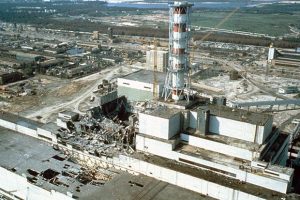Energy
65 The Confliction of Nuclear Energy
Exploring the Pros and cons of Nuclear energy and how it pertains to STS
Ellis Bryant
Introduction
The history of nuclear energy traces back to the late 19th and early 20th centuries with foundational discoveries in radioactivity by Henri Becquerel and subsequent work by Marie and Pierre Curie. However, it was the discovery of nuclear fission by Lise Meitner, Otto Hahn (Lise Meitner’s nephew) and Fritz Strassmann in 1938 that catalyzed the development of nuclear energy. The urgency of World War II propelled research into nuclear weapons, culminating into the Manhattan Project which lead to the deployment of atomic bombs. Post-war, there was a significant expansion of nuclear research for both military and civilian purposes. The first civilian nuclear power plant, Experimental Breeder Reactor I, came online in 1951, followed by the Atoms for Peace Initiative in 1953 to promote peaceful nuclear applications. Throughout the 1970s to the 2000s, nuclear power experienced both growth and challenges. Concerns over oil shortages and environmental issues drove a surge in nuclear power plant contraction, but incidents like Three Mile Island in 1979 and the Chernobyl disaster in 1986 raised safety concerns. Despite these setbacks, nuclear energy has remained an integral part of many countries’ energy production.

Figure 1: Fritz Strassmann, Lise Meitner and Otto Hahn, at the Max-Planck-Institute for Chemistry, Mainz, West Germany 1956
benefits that nuclear energy Provides
Nuclear energy has been a cornerstone of modern civilization, offering a multitude of benefits across various sectors. Foremost among these benefits is its capacity to generate vast amounts of electricity with minimal environmental impact. Unlike fossil fuels, nuclear power plants produce little to no greenhouse gas emissions during operation, making them a crucial ally in the fight against climate change. Additionally, nuclear energy provides a stable and reliable source of electricity, capable of meeting the demands of a growing population and industrial infrastructure. Furthermore, nuclear energy enhances energy security by reducing dependence on the ever-shrinking amount of imported fossil fuels that power nearly eighty percent of the world’s energy. Overall, nuclear energy stands as a highly capable source of sustainable and reliable power generation and can offer a pathway towards a cleaner and more secure future for energy production.
downfalls that nuclear energy presents
Alongside its benefits, nuclear energy also poses significant drawbacks and challenges. At the top of these concerns is the risk of accidents and catastrophic events happening, as demonstrated by incidents such as Chernobyl and Three Miles Island. These nuclear incidents loomed large in the public eye, raising questions about the safety and viability of nuclear power. Additionally, the proliferation of nuclear weapons remains a pressing global concern, with the dual-use nature of nuclear technology posing a potential threat to be made into a nuclear weapon. As far as environmental and economic drawbacks go, properly disposing of hazardous nuclear waste and expensive construction and operating costs lie at the forefront. Radioactive byproducts generated by nuclear reactors require careful handling and disposal to prevent environmental contamination and health risks. Long-term storage challenges have yet to be fully addressed and present a huge risk if left unsolved. In addition to this, many nuclear power plants are coming to the end of their lifespans with the average age of a nuclear power plant in the US being around 40 years old. High operating costs present many economical challenges due to new power plants needing to be built to continue to energy production.

Figure 2: Chernobyl nuclear power plant a few weeks after disaster. Chernobyl, Ukraine, USSR, May 1886
Connection to sts
Nuclear energy serves as a focal point for exploring the connections between science, technology, and society (STS). From it’s start, nuclear energy has been deeply connected with scientific discoveries and technological advancements, driving innovation in energy production and shaping the views of society towards energy consumption. Moreover, the development of nuclear technology has had profound social implications, ranging from concerns over environmental sustainability and public health to questions of national security and potential threats of disasters occurring. Ethical considerations surrounding nuclear energy, such as issues of risk perception and environmental impact further highlight its complex relations with society. In short, nuclear energy provides a vast context for exploring the heavy interconnections between science, technology, and society, illustrating the complexities and challenges that come with the pursuit for a sustainable and safe energy source.
conclusion
In summary, looking at nuclear energy shows just how impactful it has been in shaping history, technology, and society. It first started in science with many scientist putting forth their best efforts to thoroughly study and experiment on what is now one of the world’s primary sources of energy worldwide. Nuclear energy has its fair share of benefits such as being able to produce highly efficient amounts of energy on a sustainable level all while having a low carbon footprint and being able to replace expiring fossil fuels. But these benefits cannot be mentioned without taking into consideration the many concerns and challenges that it presents. From the rising concerns of potential disasters and nuclear threats backed up with past evidence to environmental and economical challenges. When it comes to nuclear energy, it’s not only about what’s possible, but also what’s safe. In order for nuclear energy to continue being a relied upon energy contributor for decades to come, it will be important to address the many issues and challenges that it presents all while taking advantage of the many benefits that come with it.
references
Advantages and Challenges of Nuclear Energy | Department of Energy, www.energy.gov/ne/articles/advantages-and-challenges-nuclear-energy. Accessed 29 Apr. 2024.
Igini, Martina. “The Advantages and Disadvantages of Nuclear Energy.” Earth.Org, 4 Mar. 2024, earth.org/the-advantages-and-disadvantages-of-nuclear-energy/.
“Life Cycle Energy and Greenhouse Gas Emissions of Nuclear Energy: A Review.” Energy Conversion and Management, Pergamon, 8 Apr. 2008, www.sciencedirect.com/science/article/pii/S0196890408000575?casa_token=GYuULg9-n54AAAAA%3AodAAvwhF8FlMkK1u-20dkWNgnM5JLoVIP0T9sU3PHwE9zGysJOHCv-7agV19fp_1Z3B2Yspm5Q.
“Nuclear Energy: A Pathway towards Mitigation of Global Warming.” Progress in Nuclear Energy, Pergamon, 11 Dec. 2021, www.sciencedirect.com/science/article/pii/S0149197021004340?casa_token=uxZUsvsnJ6UAAAAA%3AQeBOwX510numoj0H1rF3AygtPX2kL7P9copibY9kFl8RvKtO6EJvw9ewG9I47e5vCVsiCff0qw.
“Nuclear Energy: Status and Future Limitations.” Energy, Pergamon, 22 June 2011, www.sciencedirect.com/science/article/pii/S0360544211003653?casa_token=scj_T2Gap24AAAAA%3AcF0M_KQ-KDIfoiUFZcTWSZ9EOpTBinvKxmH28MtxjM0tnqI9W6VssCi4-YA2qlBJK4-n6fpewg.
“Outline History of Nuclear Energy.” History of Nuclear Energy – World Nuclear Association, world-nuclear.org/information-library/current-and-future-generation/outline-history-of-nuclear-energy.aspx. Accessed 28 Apr. 2024.
AI Acknowledgment
The use of ChatGPT was used to help generate the chapter outline and summaries of articles surrounding the topic of Nuclear Energy. Additionally, ChatGPT was used to help create transitions between paragraphs in order to help with the overall flow of the chapter.

